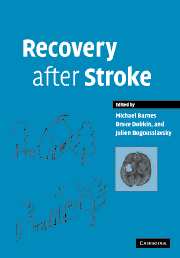Book contents
- Frontmatter
- Contents
- List of authors
- Preface
- 1 Stroke: background, epidemiology, etiology and avoiding recurrence
- 2 Principles of recovery after stroke
- 3 Regenerative ability in the central nervous system
- 4 Cerebral reorganization after sensorimotor stroke
- 5 Some personal lessons from imaging brain in recovery from stroke
- 6 Measurement in stroke: activity and quality of life
- 7 The impact of rehabilitation on stroke outcomes: what is the evidence?
- 8 Is early neurorehabilitation useful?
- 9 Community rehabilitation after stroke: is there no place like home?
- 10 Physical therapy
- 11 Abnormal movements after stroke
- 12 Spasticity and pain after stroke
- 13 Balance disorders and vertigo after stroke: assessment and rehabilitation
- 14 Management of dysphagia after stroke
- 15 Continence and stroke
- 16 Sex and relationships following stroke
- 17 Rehabilitation of visual disorders after stroke
- 18 Aphasia and dysarthria after stroke
- 19 Cognitive recovery after stroke
- 20 Stroke-related dementia
- 21 Depression and fatigue after stroke
- 22 Sleep disorders after stroke
- 23 Technology for recovery after stroke
- 24 Vocational rehabilitation
- 25 A patient's perspective
- Index
2 - Principles of recovery after stroke
Published online by Cambridge University Press: 05 August 2016
- Frontmatter
- Contents
- List of authors
- Preface
- 1 Stroke: background, epidemiology, etiology and avoiding recurrence
- 2 Principles of recovery after stroke
- 3 Regenerative ability in the central nervous system
- 4 Cerebral reorganization after sensorimotor stroke
- 5 Some personal lessons from imaging brain in recovery from stroke
- 6 Measurement in stroke: activity and quality of life
- 7 The impact of rehabilitation on stroke outcomes: what is the evidence?
- 8 Is early neurorehabilitation useful?
- 9 Community rehabilitation after stroke: is there no place like home?
- 10 Physical therapy
- 11 Abnormal movements after stroke
- 12 Spasticity and pain after stroke
- 13 Balance disorders and vertigo after stroke: assessment and rehabilitation
- 14 Management of dysphagia after stroke
- 15 Continence and stroke
- 16 Sex and relationships following stroke
- 17 Rehabilitation of visual disorders after stroke
- 18 Aphasia and dysarthria after stroke
- 19 Cognitive recovery after stroke
- 20 Stroke-related dementia
- 21 Depression and fatigue after stroke
- 22 Sleep disorders after stroke
- 23 Technology for recovery after stroke
- 24 Vocational rehabilitation
- 25 A patient's perspective
- Index
Summary
Introduction
This chapter introduces concepts about the interacting cascades of ischemiainduced, activity-dependent, and practice- and learning-driven principles that permit gains or prevent gains early and late after stroke. Subsequent chapters will look more specifically at nervous system adaptations and outcomes associated with mechanisms of neuroplasticity and specific biological and training-related interventions. The biological mechanisms and therapeutic applications of training- induced plasticity for motor control and cognitive functions have been more fully reviewed across neurological diseases in other texts (Dobkin, 2003). We illustrate some of these principles by examining gains in the motor control for walking in hemiparetic patients and by describing some of the substrates of biological changes that may contribute to those gains.
Recovery: restitution, substitution, or compensation?
Patients tend to improve over time after an acute stroke, in a general relationship to a few defined impairment groups (Table 2.1). Gains occur in motor impairments, with the largest increases in strength occurring in patients who are not initially paralyzed (Hendricks et al., 2002). Six months after a non-hemorrhagic stroke, approximately half of patients have no significant motor impairment. For motor-related abilities, functional gains tend to follow the level of recovery of selective movement skills. The level of motor control for walking, which perhaps best correlates with manual muscle testing of lower extremity strength, runs in parallel with the level of independence for walking (Jorgensen et al., 1995), but of course it is not the only impairment that can compromise ambulation. Any analysis is limited by how we measure strength and walking skills. Are we measuring selective strength of individual muscle groups? Will the scale use dynamometry or a non-parametric scale such as the British Medical Council scale, with itsstandard five grades? Can we agree that the three-step scale of the Barthel Index or the seven-step scale of the Functional Independence Measure adequately cover the meaning of recovery, or should walking speed over 50 feet (15 m) and walking distance in six minutes, or symmetries of stance and swing times, kinematics, ground reaction forces, and the pattern of muscle activations be included to better ascertain what we mean by recovery? Do assessment procedures reflect changes in the range of adaptative strategies that patients may incorporate over time? Principles of recovery may be subsumed within three general changes within the sensorimotor networks (Dobkin, 2003): restitution, substitution, and compensation.
- Type
- Chapter
- Information
- Recovery after Stroke , pp. 47 - 66Publisher: Cambridge University PressPrint publication year: 2005
- 15
- Cited by



